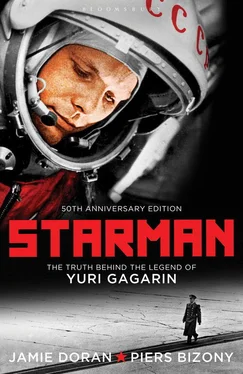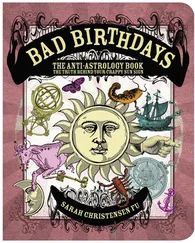Korolev planned to launch a cosmonaut by the end of 1960, but Vostok still refused to cooperate. On December 1 another hapless pair of dogs was burned to a crisp when their re-entry ball came down at too steep an angle. On December 22 (the rate of launches was frenetic) a fresh duo of dogs survived an emergency ejection in their special pod, when the R-7 booster ran out of thrust halfway up its climb into orbit. The upper stage’s engine did not catch alight and Vostok fell back to earth.
The medical experts exposed many dogs to unpleasant laboratory experiments with barely a second’s thought, but the rocket engineers had more feeling for their canine cosmonauts. Yuri Mazzhorin remembers a dramatic race-against-the-clock rescue, in which the space community’s concern for one of their animals overcame their fear of the 10-kilo explosive devices in the prototype capsules. ‘In 1960, approximately in March, we launched a one-hour flight with a dog. All of a sudden we were advised that the flight was aborted and we weren’t getting any more data. Straight away we calculated where the capsule would fall. It was approximately in the area of Tunguska, Siberia region, coincidentally near where a big meteorite fell in 1908. Everyone was upset and said it was a pity the dog would be blown up. Suddenly a signal came through from radio aerials attached to the parachute lines. It meant the ship had survived.’
This was good news, except for a couple of minor details. When they realized the orbit was failing, the controllers had sent up a ‘destruct’ command. Nothing happened. Obviously the ship was still in one piece when it began its uncontrolled re-entry, but there was no signal to confirm that the dog had escaped in its ejection pod. Perhaps it was still trapped in the re-entry ball? And was the explosive back-up timer activated? If so, the dog would land with a terrible bump, only to be blown up after sixty-four hours!
‘Ten people immediately boarded an Ilyushin-14 at Baikonur. There was a bad fog, but they took off anyway.’ Cooperative KGB officers were despatched to the more colourful establishments of Samara (then Kuibishev) on the Volga, hunting for a couple of off-duty time-bomb experts with a shared love of drink and girls. ‘They were taken from a party, in quite a state, and they were given a plane to Siberia, and we were counting the time left. Perhaps the charge would go off before sixty-four hours? Who knows what the timer was doing? It was a big risk.’
The capsule had come down close to the Arctic Circle. This being March, the daylight in that part of the world lasted no more than a few hours. Fortunately the parachute was spotted from the air just before darkness fell. The bomb was defused and the dog was saved.
In part, this drama was created by the difficulty of maintaining proper radio contact with a spacecraft. The Americans at NASA had the advantage of a worldwide network of listening posts to keep in contact with their Mercury space capsules. They made diplomatic arrangements with Australia, Nigeria, India, the Canary Islands and Mexico to site large and powerful radio dishes on their territory. Communications engineers then laid down an extensive grid of relay towers and undersea cables to connect these stations with the flight managers at Cape Canaveral. (The well-known mission control centre in Houston had not yet been constructed.) In all, the ‘Mercury Tracking Network’ was a diplomatic and technical achievement just as impressive as the spacecraft itself. [8] A full account of the Mercury programme can be found in Swenson, Loyd, Grimwood, James & Alexander, Charles, This New Ocean: A History of Project Mercury , Washington, DC: Government Printing Office, NASA SP-4201, 1966.
It formed the basis of an international system that functions to this day. NASA’s spacecraft are never out of communication, unless they disappear for a while behind the moon, or another planet.
Soviet Russia was unable to make such tidy arrangements, because their foreign allies did not live in the right places. Once a spacecraft had disappeared over the farthest horizon of home territory, it was out of communication. The solution was to equip a fleet of four 12,000-tonne cargo ships with special radio masts and send them out into the world’s oceans. They transmitted spacecraft data back to Russia, where the signals were in turn relayed to Baikonur for Korolev’s inspection. Because the cargo ships’ radio pulses were so easy for Westerners to intercept, all the telemetry had to be coded for security. Mazzhorin says, ‘Our vessels were observed from the air. The planes came very close, and took many pictures. The [foreign observers] never boarded us, though they probably guessed the ships’ purpose from their locations and sailing times. If they did board, the crew were instructed to burn all their code books immediately in a special stove. As soon as each space mission was over, the vessels would carry on and deliver their cargoes – grain, palmira seeds or whatever – to earn money.’
On March 25, 1961, one month ahead of Yuri Gagarin, Ivan Ivanovich flew for the first time, dressed in the same type of spacesuit and equipped with the same model of ejection seat and parachute harness. He flew his Vostok well, and took time to send some radio messages back home, although his observations about space were somewhat strange. In fact, he relayed instructions for making soup: schi (cabbage soup) and borscht with beetroot and sour cream. The exact details of the recipe are now lost, but it seems to have been a deliberate attempt to confuse any Western listening posts monitoring the flight.
Ivan’s descent and landing caused great anxiety for witnesses on the ground. Local villagers saw him come down under his own parachute, and they decided that something did not look quite right. The instant Ivan’s feet touched the ground he fell over, apparently unconscious. Naturally the villagers ran over to help, but a cordon of troops quickly surrounded the cosmonaut’s prostrate body. The soldiers made no effort to help, but simply stood around him as if to let him die. The villagers were appalled. [9] On March 16, 1996, Sotheby’s auction house in New York held its second sale of Russian space hardware and memorabilia. Lot 25 consisted of ‘Ivan Ivanovich’s’ capsule, stripped of most of its interior equipment but still clearly recognizable as a Vostok prototype. The catalogue’s explanatory notes, prepared with the help of OKB-1 engineer-cosmonaut Konstantin Feoktistov, with additional material by James Oberg and various Russian historical experts, described Ivan’s adventures in full. See Sotheby’s Sale Catalogue 6753, Russian Space History , New York: March 16, 1996.
In recent times, a sort of Russian ‘Roswell’ legend has attached itself to this incident. An unacknowledged cosmonaut went up before Yuri Gagarin and was killed during the return phase… History was not best served when a pro-communist British newspaper, the Daily Worker , published a story just two days before Gagarin’s flight, written (or, rather, concocted) by its Moscow correspondent Dennis Ogden. A renowned test pilot had been injured in a car crash, but Ogden decided that the man was a cosmonaut who had come down to earth badly in a spaceship called ‘Rossiya’. As recently as 1979, experts at the British Interplanetary Society took some of these rumours seriously:
Some controversy surrounds the name of the first man in space. Edouard Bobrovsky, a French broadcaster who visited Moscow in April 1961, revealed that according to reliable sources, Sergei Ilyushin, son of the famous Russian plane designer and a dare-devil pilot, used his influence to go into space himself, three or four weeks before Gagarin. After his return to earth the recovery team found him badly shaken. Sergei Ilyushin has been in a coma ever since. [10] Popescu, Julian, Russian Space Exploration , London: Gothard, 1979, p. 16.
Читать дальше












